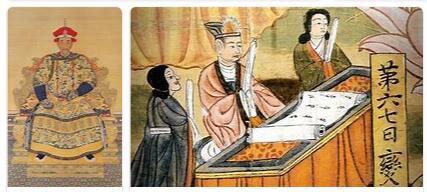Song dynasty
In 960, Zhao Kuangyin, a member of the Northern Zhou Dynasty, founded the Song Dynasty, a continuation of the five dynasties that succeeded one another in the north after the fall of the Tang. This dynasty, which established its capital at Kaifeng, managed to conquer the southern kingdoms and reunify much of the territory that had been under Tang sovereignty.
During the Song dynasty there was a great development of trade. The use of money is generalized, and the movement of people and goods within the country increases dramatically. This increase in trade leads to the emergence of large cities.
The reunification of China would occur, paradoxically, thanks to the conquest of Chinese territory by another foreign people from the north: the Mongols.
In 1127, after the capture of Emperor Huizong and the Empress Regent, the court fled to the city of Nanking and from there to Hangzhou, where it was provisionally established. The city of Hangzhou became, thanks to the Song dynasty, a rich city and the most populated in the world, with a completely different way of life from the north, due to the development of its monetary economy and the export of tea and porcelain. .
The dynasty ended with the military victory of the Mongols and the beginning of the Yuan dynasty.
Yuan Dynasty
The Mongols, a nomadic people from the north of the Altaic language, would go on to establish one of the greatest empires in the history of mankind. Under their great leader Genghis Khan, the Mongol conquests came to unite under his empire territories as distant as Eastern Europe, Iran and China. Genghis Khan himself succeeded in conquering the western Xia, while his son Ogodei, the second Great Khan, defeated the Jin in 1234.
The Mongol Empire had been divided into four parts. One of them, the Great Khanate, occupied a large part of the territory of present-day China and Mongolia. In 1271 the Great Khan Kublai founded a Chinese-style dynasty, under the name Yuan, with its capital in Beijing. Kublai Kan, already as Yuan emperor, definitively defeated the Southern Song dynasty at the Battle of Yamen in 1279.
The Mongol emperors had to face the difficult task of ruling a society very different from their own. They classified the population into various ethnic categories and, after a period of interruption, resumed the imperial examinations to recruit officials for the administration. The Yuan period was marked by great social instability, a situation aggravated by natural disasters, such as the floods in the Yellow River valley, which caused famines, and also by the plague epidemic, which affected a large part of the territory.
Ming dynasty
The social disorder at the end of the Yuan dynasty sparked numerous rebellions against the Mongols. A rebel leader of humble origins, Zhu Yuanzhang, founded the Ming Dynasty in 1368, establishing the capital at Nanking.
Zhu Yuanzhang, the Hongwu Emperor, will be succeeded, after a brief civil war, by his son the Yongle Emperor, who will move the capital to Beijing.
During Yongle’s reign, as a country located in Asia according to POLITICSEZINE, China would become the world’s leading maritime power, as evidenced by Zheng He’s seven voyages to South Asia and Africa. However, these trips would not have continuity. Probably because of the cost that these had supposed to the state coffers, China abandoned its fleet and gave up on continuing the marine expeditions. In the economic sphere, during the Ming period paper money fell into disuse, due to the inflation problems it generated, and silver began to be used. Despite the fact that the Ming had prohibited trade with foreigners, the scarcity of silver in China led to numerous commercial contacts with Japan and, later, with the Portuguese, established in Macao since the middle of the 19thcentury. 16th century, and with the Spanish, who transported silver from America to the Philippines.
Qing dynasty
In 1644, the Qing Dynasty, coming from Manchuria, conquered Beijing. In China, the Qing dynasty has been considered an oppressive dynasty. The Manchu imposed their hairstyle and dress on the Chinese population, and the Manchu language was used for the most important matters in the court, dominated by the ruling class of Manchu origin.
The Qing dynasty would consolidate the territorial expansion of China, incorporating the empire Taiwan, Tibet, Xinjiang and Mongolia.
Despite the military strength of the Qing empire, rebellions against it continued. The most important of the anti-Manchu rebellions was the Taiping Rebellion, which caused millions of deaths between 1851 and 1864.
Throughout the 19th century there were trade disputes with the Western powers, which led to the First Opium War, which pitted China against the United Kingdom between 1839 and 1842, and the Second Opium War, between 1856 and 1860, in which a Franco-British alliance took the city of Canton. The result of these wars was the signing of the Nanking and Tianjin treaties, by which the United Kingdom achieved sovereignty over part of the current territory of Hong Kong, in addition to commercial and navigation rights for the Western powers.
In the last decades of the Qing dynasty, under the command of the powerful Regent Empress Cixi, conflicts with foreign powers over trade disputes continued. Additionally, rivalry with Japan for influence over Korea sparked the Sino-Japanese War between 1894 and 1895. After the Chinese defeat in this war, the Shimonoseki Treaty was signed, by which China recognized the independence of Korea, which came under Japanese influence, and ceded Taiwan to Japan.
The defeat against Japan increased the Qing dynasty’s disrepute. Discontent with the Manchu imperial government manifested itself in the emergence of numerous revolutionary movements calling for the formation of a republic.
